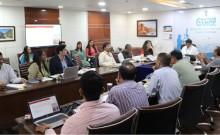Climate change is a touchy subject in Champagne because just as France prepares to host world leaders for talks on how to slow it next month, producers of the regions famous sparkling wine have seen only the benefits from global warming so far. The 1.2C increase in temperatures in the region over the past 30 years has reduced frost damage. It has also added 1% in the level of alcohol and reduced acidity, making it easier to comply with strict production rules, according to Champagne makers group CIVC.
The impact of global warming in the Champagne region is that for the last two decades we have had hardly any major frosts. We have had much larger harvests and we have had largely excellent vintages for the last 20 years. So in the Champagne region, its positive. Even though I think globally climate change is a top priority, as far as Im concerned global warming is the Third World War, said Pierre-Emmanuel Taittinger, director general of the champagne house carrying the same name, in their headquarters in Reims.
Champagnes chalky soil, where Taittinger stores 3 million bottles in long and dark alleys, is another key asset for the region to fight climate change as it can retain water and release it during warmer weather. But the effects are not all positive, wine maker Jean-Pierre Vazart said, leading to unpredictable harvests.
The thing you can be sure about is that the date of the harvest is never the same, and that it can change dramatically over a short period of time. [The year] 2003 is an example of a very early harvest – the first time we picked the grapes in August – and then...in 2013, 10years later, we picked the grapes in October. So climate change is here, we can see it, and from time to time, we can see big variations, he said.
Over the past 30 years, harvesting has taken place two weeks earlier on average, as winemakers tried to master rising sugar levels. To fight hot or dry weather, winemakers also use techniques, such as removing grass competing for water in vineyards or keeping more leaves to protect grapes from the sun.
CIVC has launched experimental vineyards, most of them in the research centre of Plumecoq in Chouilly to prepare for worst-case scenarios. For more than 20 years, the industry has been investing in research and development aimed at controlling the possible consequences of crop protection, such as swapping chemical fertilisers for natural alternatives.
Our big challenge in Champagne is sustainable winemaking, to anticipate changes in the climate but also to control the vineyards processes. In Champagne, we have reduced the workload in the vineyard by more than 50%. We have gradually swapped chemical fertilisers for natural fertilisers. Those chemical fertilisers had a strong greenhouse effect because they used nitrogen, but today they have been swapped for natural fertilisers, CIVC Director General Vincent Perrin said.
The result today is a reduction in the quantities of pesticides used and half of the products used in Champagne are approved for organic use. Data collected over the past 20 years indicates that Champagne soils today enjoy an excellent level of biological activity, CIVC said.
For this generation, which is the first to be fully aware of climate change, we know we have a complete toolkit to help us provide solutions to, and to plan for, 1, 2 or even 3 degrees of global warning. But considering the required time to roll out those experiments and then to extend them over 34,000 hectares with 15,000 winemakers, we need time, Perrin said.

















